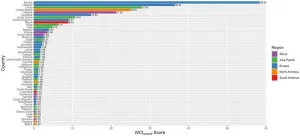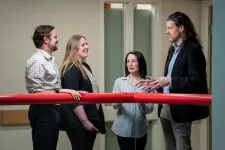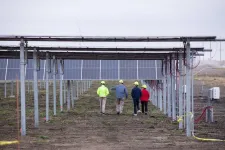(Press-News.org) A newly developed World Cybercrime Index shows that most cybercriminal threats are concentrated in several countries, with different countries associated with distinct cybercrime types. Miranda Bruce (University of Oxford/University of New South Wales), Jonathan Lusthaus (University of Oxford), Ridhi Kashyap (University of Oxford), Nigel Phair (Monash University), and Federico Varese (Sciences Po) present these findings in the open-access journal PLOS ONE on April 10, 2024.
Worldwide, cybercrimes are estimated to cost hundreds of millions to perhaps trillions. However, locating where offenders tend to operate poses challenges because they often use strategies to mask their locations, and legal documents capture a limited number of cases that may not be globally representative.
To help clarify, the authors surveyed leading cybercrime experts on the geographical distribution of cybercriminal threats. They developed and refined the survey through expert focus groups and pilot surveys before distributing it widely in 2021.
A total of 92 top cybercrime experts from around the world completed the survey, in which they named the countries they believed to be the biggest hubs for five cybercrime categories—technical products or services, attacks and extortion, data or identity theft, scams, and cashing out or money laundering.
The researchers used the survey results to construct the novel World Cybercrime Index, enabling comparison between countries. It suggests that cybercriminal threats are primarily concentrated in a small number of countries, with China, Russia, Ukraine, the US, Romania, and Nigeria ranking in the top 10 for each of the five categories. However, 97 countries were named by at least one expert as being a hub for a particular category.
Different countries were associated more often with distinct categories. For instance, cybercrimes related to technical products or services were the top category in China, data or identity theft in the US, and attacks and extortion in Iran.
The World Cybercrime Index could aid future cybercrime research, and it could help target preventive efforts tailored to specific hubs. However, the authors also note the need to address their study’s limitations, such as by including a larger, more globally representative pool of experts, reducing variation in participants’ interpretations of survey questions, and addressing the sometimes-blurred lines between profit-driven cybercrime and state-protected actions.
The authors add: “Profit-driven cybercrime, often seen as a fluid and global type of organized crime, actually has a strong local dimension. The World Cybercrime Index shows that 97 countries are significant cybercrime hubs, but most cybercrime is produced in just six of them.”
#####
In your coverage please use this URL to provide access to the freely available article in PLOS ONE: https://journals.plos.org/plosone/article?id=10.1371/journal.pone.0297312
Citation: Bruce M, Lusthaus J, Kashyap R, Phair N, Varese F (2024) Mapping the global geography of cybercrime with the World Cybercrime Index. PLoS ONE 19(4): e0297312. https://doi.org/10.1371/journal.pone.0297312
Author Countries: UK, Australia, France
Funding: This project has received funding from the European Research Council (ERC) under the European Union’s Horizon 2020 research and innovation program (Grant agreement No. 101020598 – CRIMGOV, Federico Varese PI). FV received the award and is the Primary Investigator. The ERC did not play any role in the study design, data collection and analysis, decision to publish, or preparation of the manuscript. Funder website: https://erc.europa.eu/faq-programme/h2020.
END
Most cybercriminal threats are concentrated in just a few countries
A new World Cybercrime Index could help target investigative and preventive efforts more efficiently
2024-04-10
ELSE PRESS RELEASES FROM THIS DATE:
US building footprints could help identify neighborhood sociodemographic traits
2024-04-10
An analysis of building footprints in major US metropolitan areas identifies five different neighborhood types that vary in footprint size, shape, and placement, and which are statistically associated with varying neighborhood socioeconomic and demographic traits. Noah Durst of Michigan State University, US, and colleagues present these findings in the open-access journal PLOS ONE on April 10, 2024.
People have long studied the shape and placement of human settlements—“neighborhood morphology”—to help inform urban planning and management. Recent technological advancements, such as high-resolution satellite imagery and more powerful computational ...
Indigenous Australian message sticks, which feature markings to convey messages over long distances, analyzed for first time at scale through new database of 1,500 artifacts
2024-04-10
Indigenous Australian message sticks, which feature markings to convey messages over long distances, analyzed for first time at scale through new database of 1,500 artifacts
###
Article URL: https://journals.plos.org/plosone/article?id=10.1371/journal.pone.0299712
Article Title: AMSD: The Australian Message Stick Database
Author Countries: Australia, Germany
Funding: The lead author (Piers Kelly) receives salary and project funding specifically for the research described in this paper. He is funded by an ARC Discovery Early Career Researcher ...
Mixed diets balance nutrition and carbon footprint
2024-04-10
What we eat can impact our health as well as the environment. Many studies have looked at the impacts of diets in very general terms focused at the level of food groups. A new study led by researchers at the University of Tokyo explores this issue following a more nuanced dish-level approach. One of the benefits of this kind of study is that people’s connections with their diets vary around the world and have strong cultural associations. Knowledge of the impacts of diets using dishes rather than broad food groups can help individuals make informed choices and those in the food industry improve ...
New quantum material promises over 190% quantum efficiency in solar cells
2024-04-10
Researchers from Lehigh University have developed a material that demonstrates the potential for drastically increasing the efficiency of solar panels.
A prototype using the material as the active layer in a solar cell exhibits an average photovoltaic absorption of 80%, a high generation rate of photoexcited carriers, and an external quantum efficiency (EQE) up to an unprecedented 190%—a measure that far exceeds the theoretical Shockley-Queisser efficiency limit for silicon-based materials and pushes the field of quantum materials for photovoltaics to ...
AI powered “digital twin” models the infant microbiome
2024-04-10
The gut microbiome has a profound impact on the health and development of infants. Research shows that dysbiosis—or imbalances in the microbial community—is associated with gastrointestinal diseases and neurodevelopmental deficits. Understanding how gut bacteria interact, and how these interactions may lead to some of these problems, however, is difficult and time consuming through traditional laboratory experiments.
Researchers at the University of Chicago have developed a new generative artificial intelligence (AI) tool that models the infant microbiome. This “digital ...
World-first “Cybercrime Index” ranks countries by cybercrime threat level
2024-04-10
Following three years of intensive research, an international team of researchers have compiled the first ever ‘World Cybercrime Index’, which identifies the globe’s key cybercrime hotspots by ranking the most significant sources of cybercrime at a national level.
The Index, published today in the journal PLOS ONE, shows that a relatively small number of countries house the greatest cybercriminal threat. Russia tops the list, followed by Ukraine, China, the USA, Nigeria, and Romania. The UK comes in at number eight.
Co-author of the study, Dr Miranda Bruce from the ...
A study in Science Advances suggests liquid biopsy could detect and monitor aggressive small cell lung cancer
2024-04-10
A new lab assay developed by researchers at Fred Hutch Cancer Center could make diagnosis and treatment of small-cell lung cancer and non-small cell lung cancer easier.
The blood-based test, also called a “liquid biopsy,” can detect differences between types of lung cancer by examining patterns in cell-free tumor DNA in blood samples. It’s a desirable option for detecting small-cell lung cancer (SCLC) as standard needle biopsies fail due the number of smaller tumors typically present and the variety of tumor subtypes that indicate different treatment pathways.
“There ...
New drug prevents flu-related inflammation and lung damage
2024-04-10
(MEMPHIS, Tenn. – April 10, 2024) Infection with the influenza virus leads to lung injury through inflammation over-activation that causes collateral damage to cells required for breathing. Such damage can be life-threatening, but scientists have a new preventative treatment. A team from St. Jude Children’s Research Hospital, University of Houston, Tufts University School of Medicine and Fox Chase Cancer Center created a drug that can prevent flu-induced lung injury. In a mouse model, the ...
Taking on the global challenge of hidden hunger
2024-04-10
COLUMBIA, Mo. — More than 2 billion people suffer from hidden hunger, a form of malnutrition where individuals lack essential micronutrients — like vitamins and minerals — even though they consume what appears to be an adequate amount of calories.
University of Missouri researcher Kiruba Krishnaswamy is focused on tackling this global challenge. She recently received a five-year, $532,000 Early Career Development (CAREER) award from the National Science Foundation (NSF) — the NSF’s most prestigious award for early-career faculty — in support of her project titled ...
Engineers making a better, more profitable grid for distributing solar power
2024-04-10
AMES, Iowa – If you’re the Midcontinent Independent System Operator – the organization that manages the flow of high-voltage electricity across a central stripe of the U.S. and Canada, from Manitoba, Michigan and Minnesota through Iowa and all the way to Louisiana – you want energy supplies to meet the energy demands of 45 million people.
“We make sure the right amount of electricity is generated and transmitted to our member utilities,” says the regional grid operator’s website.
Balancing power supply and demand is complicated these days. Electricity is no longer exclusively generated by power plants using coal- or natural ...
LAST 30 PRESS RELEASES:
NCCN Summit seeks to improve care for veterans and first responders with cancer from line-of-duty exposure
ERC Consolidator Grant for soft robotics researcher
Dual-action arts and wellbeing program transforms dementia care
The global plastic waste trade contributes to coastal litter in importing countries, study shows
UT Dallas partners with Tech Mahindra on AI innovation
Blinking less could signal the brain is working harder to listen, Concordia study shows
Male bonobos track females’ reproductive cycle to maximize mating success
New report outlines science priorities for human Mars exploration
Want to curb cannabis-related crashes? Don’t forget older adults, study finds
Expectant management vs medication for patent ductus arteriosus in preterm infants
Pew funds 7 new biomedical research collaborations
The ERC selects 349 mid-career researchers for €728 million in Consolidator Grants
ERC Consolidator Grant awarded to CISPA researcher Rayna Dimitrova
Antimicrobial effects of Syzygium aromaticum and Salvadora persica against common peri-implantitis pathogens in vitro
EVs pose no greater risk to pedestrians than conventional vehicles
Modeling microplastic accumulation under the ocean surface
Pompeii offers insights into ancient Roman building technology
University of Utah engineers give a bionic hand a mind of its own
Transient and long-term risks of common physical activities in people with low back pain
Health care contact days in older adults with metastatic cancer
Brain resilience science reshapes psychiatry from treating illness to building strength
An assessment of the antidepressant potential of deramciclane in two animal tests
Pitt and UPMC study finds epigenetic signature of pediatric traumatic brain injury, paves way for precision recovery tools
Brain discovery opens door to earlier detection of metabolic syndrome in women
SwRI-led study provides insight into oscillations in solar flares
Announcing the third cohort of the Hevolution/AFAR new investigator awards in aging biology and geroscience research
GeoFlame VISION: Using AI and satellite imagery to predict future wildfire risk
Nationwide study suggests that water treatment methods may impact the risk of legionnaires’ disease
Oyster larvae on drugs move slowly and are stressed
Targeting a specific brain circuit may help prevent opioid relapse, WSU study finds
[Press-News.org] Most cybercriminal threats are concentrated in just a few countriesA new World Cybercrime Index could help target investigative and preventive efforts more efficiently









